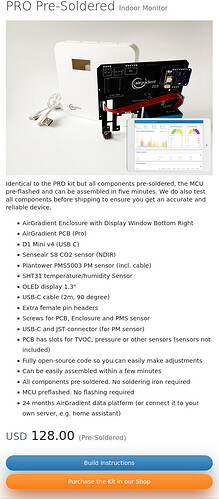The work around for the bootloop problem is to flash using the “automatic” flashing button within the build instructions, since it appears to be an earlier version of the software. This solved the problem of the bootloop. I mean, they should really fix the actual error, too, but you will be able to get your device to work again.
However, that will not solve the inherent calibration problem for conditioned spaces: the air temperature and humidity can be radically different indoors and out, and calibrating in one environment will give you inaccurate readings in the other. The farther apart the two conditions are, the worse the error in the reading will be. After manually calibrating outdoors recently, my monitor read 200ppm lower indoors. The ONLY way to fix this would be to know the equations for the effects of temperature and humidity in this particular model of sensor and then write software that would adjust the reading according to the temp and humidity at the time of the reading compared to the conditions at calibration. This should be possible given sufficient information about the sensor properties, but it’s not exactly a DIY proposition.
I suspect that the owner here has a hard time understanding how significant this problem is in our market, because the sealed buildings characteristic of North America are extremely uncommon in Thailand. I imagine it is hard to fathom how much time Americans spend in buildings that don’t even have windows that open. Inadequate ventilation is not just common here, it is the overwhelming norm. OSHA regulations in the US permit workers to be in environments at 5000ppm CO2 for eight hours a day, and buildings are ventilated accordingly at extremely low levels. Most older homes do not have adequate ventilation because as owners have upgraded leaky windows and attics, they have not routinely added active energy recovery ventilation. I would strongly suspect the majority of North American homes and workplaces spend more than half the year without ever coming to environmental equilibrium.
Where I live, summertime daily high temperatures outdoors are typically 10-20 degrees F hotter than inside my house, which I keep at 77. Office buildings are kept MUCH cooler. Relative humidity outdoors is frequently 70-85% , while the house is usually around 50%. Temperature differences can be much more extreme than that in winter, obviously. So it’s simply not feasible to get accurate readings most of the year from a monitor without software compensating for how the temp and humidity will affect the raw sensor output.
I’m writing to other monitor companies to determine which of them do this, but my money is on those that also produce scientific instruments.

